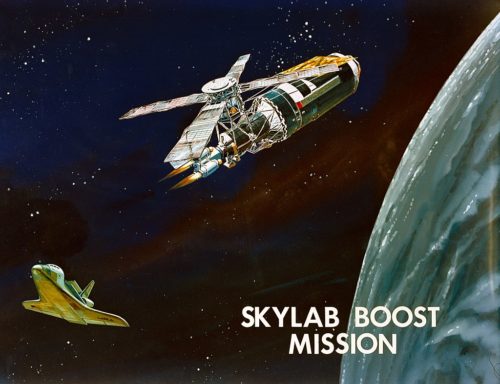
The engines of the Teleoperator Retrieval System (TRS), seen docked to Skylab, perform a lengthy “burn” to either deliver the old space station into a higher, more stable orbit or to prepare it for a controlled, destructive re-entry. Image Credit: NASA
Visiting space stations is, and always has been, a complex and challenging endeavor; yet to the layman in the street it carries an element of the “ordinary” these days, as the world sees crews of astronauts and cosmonauts launched periodically throughout the year to begin multi-month increments aboard the International Space Station (ISS). Late in 2019, if all goes well, the first crews will rise from U.S. soil aboard the long-awaited Commercial Crew vehicles. But a very definitive line exists between “visiting” a space station and “rescuing” one from potential, impending disaster. The Soviets did it triumphantly to salvage their out-of-control Salyut 7 in June 1985. And 40 years ago, this fall, had history played out more kindly, the Space Shuttle might have carried out a daring and dramatic rescue of the ailing Skylab space station. Had it flown as intended, a whole new history of the shuttle program could have unfolded.
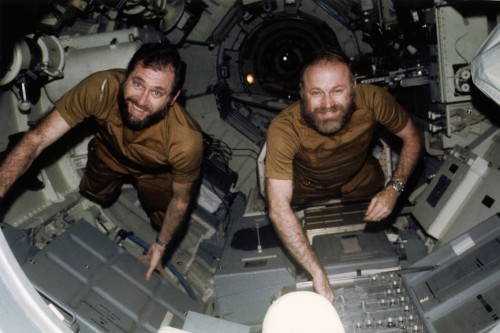
Bill Pogue (left) and Gerry Carr, pictured aboard Skylab during their 84-day mission, which took place between November 1973 and February 1974. Photo Credit: NASA
Skylab was last inhabited by its third long-duration crew—astronauts Gerry Carr, Ed Gibson and Bill Pogue—who departed in February 1974 after a then-world-record-setting 84 days in space. With the shuttle expected to come online later that decade, hopes were high that the versatile, reusable spacecraft could be tasked to visit the old hulk and bring it back to an operational stature. In the days after the departure of Carr’s crew, NASA engineers remotely vented the atmosphere of Skylab, established it in a gravity-gradient-stabilized attitude and shut down most of its on-board systems. It could respond to telemetry command, whenever its giant solar arrays were exposed to sunlight, but with a troublesome control moment gyroscope and erratic behavior noted on two of its coolant loops there remained a question mark over whether it could indeed be reoccupied.
That said, the hope remained alive. On 16 March 1978, four pairs of astronauts were assigned by NASA to begin training for early Orbital Flight Test (OFT) shuttle missions. One of them was Apollo 13 veteran Fred Haise and seasoned Skylab pilot Jack Lousma, although it was not immediately made clear that they would fly the mission to rescue the station. “The space agency is currently considering a mission to boost Skylab into a higher orbit during one of the OFT flights,” NASA noted in its press release announcing the crews. “If the decision is made to implement the plan, prime and backup flight crews will be selected from those named.”
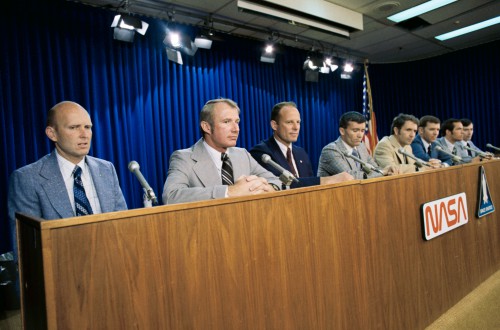
In March 1978, a “pool” of crew members were announced for the first four Orbital Flight Tests (OFTs) of the shuttle. Among them were Jack Lousma (third from left) and Fred Haise (fourth from left), who might in an alternate history have flown the salvage mission to Skylab. Photo Credit: NASA
By this time, efforts were already underway to contact Skylab and activate its command and telemetry systems, after which it was hoped that plans could be executed to determine and perhaps modify the station’s orbital attitude. “Current NASA predictions indicate that the Skylab will re-enter the atmosphere sometime between early summer 1979 and the second quarter of 1980,” it was noted. “NASA is hopeful it will be able to rendezvous with Skylab on a Space Shuttle test flight in October 1979 to remotely maneuver a propulsion stage to dock with Skylab and use this stage to either propel Skylab to a higher orbit for future use or cause it to re-enter the atmosphere in a controlled manner to ensure that debris would land in a remote area of an ocean.”
The success of the early communication attempts led to steps in June 1978 to effect several attitude-change steps, potentially increasing Skylab’s orbital lifetime by six to 12 months beyond that date. However, NASA could not have anticipated a marked increase in solar activity at the end of the decade and its effect upon Earth’s upper atmosphere. Early calculations estimated that solar action and increasing atmospheric densities would cause Skylab’s orbit to become susceptible to increased drag, dropping by perhaps 20 miles (32 km) in altitude by 1980 and faster within a couple of years after that. Sometime around March 1983, the old station would finally burn up in the atmosphere.
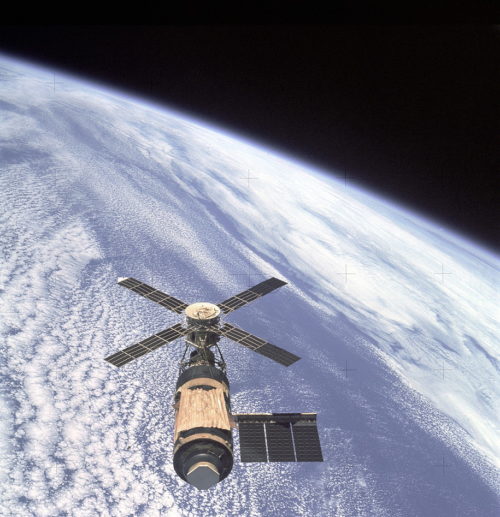
One of the final views of Skylab in orbit, as seen directly by human eyes, during the departure of the third crew in February 1974. Photo Credit: NASA
With the shuttle slated for its maiden voyage in 1979, it seemed highly plausible that it would be around to save Skylab. But as early as 1977, the National Oceanic and Atmospheric Administration (NOAA) cautioned that the solar cycle at that time was the second most-intense in a century-long history of record-keeping, indicating that Skylab might fall to Earth far sooner than expected. By December 1977, the American Geophysical Union heard that the current crop of sunspots was of particular intensity. Notwithstanding the naysayers, NASA pressed on planning to rescue the station. There was no single reliable means of predicting sunspot activity which was universally accepted by the entire solar science community and, from Lousma’s perspective, the crew continued training regardless. “Fred and I would come into work every morning,” he told a NASA oral historian, “and they’d have a picture of the Sun and…where the Skylab was on the wall”.
Aside from solar worries, the shuttle itself was the most technologically complex machine ever developed and came with its own problems. Engineers predicted that its systems would not be sufficiently tested and flight-proven until at least its fifth mission, which would almost certainly be too late for Skylab. Rendezvous, docking and a potential reboost would have to be abandoned in favor of a remote-controlled rocket engine. In September 1977, NASA green-lighted a two-year program to build hardware and in November Martin Marietta Corp. was awarded an initial $1.75 million letter contract to study options for a Teleoperator Retrieval System (TRS).
This boxy device, about the size of a small truck, was laden with propellant tanks and engines and could be flown as soon as the shuttle’s third orbital mission. It would be remotely guided towards Skylab by Haise and Lousma. NASA would then have two options: either fire the TRS engine and cause Skylab to begin a controlled, destructive dive into the atmosphere for safe disposal or insert it into a higher, storage orbit for subsequent use. Delivery of the TRS to Cape Canaveral in Florida was slated for August 1979 and it was hoped that it would fly with on the third shuttle mission a few weeks later.
Had their mission taken place as intended in September 1979—40 years ago, this month—Haise and Lousma confidently expected to spend five days in space. In his oral history, Lousma related that they would have maintained a station-keeping posture about 1,000 feet (300 meters) from Skylab, after which they would have deployed the TRS using the shuttle’s Canadian-built Remote Manipulator System (RMS) mechanical arm. In Lousma’s words, it would have been maneuvered “like a radio-controlled airplane” to dock with the station. It was indeed a daring endeavor. “The mission had never been planned to begin with, so the shuttle didn’t have rendezvous radar,” Lousma related. “Fred got busy and started getting that implemented and also developing rendezvous procedures. I worked with Martin Marietta [as] the lead on the [TRS] development.” But in many minds the odds of pulling off the mission were patchy. Johnson Space Center (JSC) Director Chris Kraft wanted little to do with it and even then-NASA Administrator Robert Frosch felt that the chances of successfully reboosting Skylab were 50-50 at best.
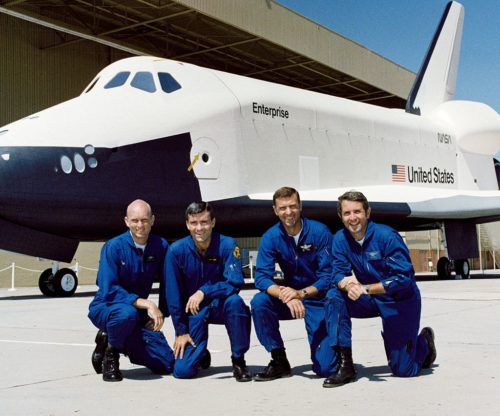
Seen here during the Approach and Landing Tests (ALTs) of Enterprise, Fred Haise (second left) might have commanded the shuttle rescue mission to Skylab. Photo Credit: NASA
For their part, Haise and Lousma continued their training with vigor. TRS simulations were done at NASA’s Marshall Space Flight Center (MSFC) in Huntsville, Ala. “We knew that Skylab wasn’t just sitting there motionless, waiting to be docked with, but it was actually augering through the sky with a motion that made the nose of it wobble in a circle,” said Lousma. “When we designed the booster package, it had to be capable of being flown so it could match that wobble of the docking port around a centerline. I had to fly that booster over there and match that circular motion and have enough power in the control system to make sure that could be done. We simulated [the] known wobble of the Skylab and made sure we could get to that, then we added to it and made a bigger wobble so we could “size” the control system. That was part of the development.”
But changing circumstances soon overtook everyone. Efforts to revive Skylab in early 1978 were successful, but the nascent shuttle was less ready to go and its maiden voyage was not expected until at least the fall of 1979. This would correspondingly push Haise and Lousma’s mission until November 1979 at the soonest. The final nail in the coffin came in December 1978, when two test-stand failures of the troubled Space Shuttle Main Engine (SSME) eliminated any chance of a maiden launch in 1979. Revised North Americal Aerial Defense Command (NORAD) data indicated that Skylab would re-enter in July-August 1979 and it became obvious that all NASA could do was focus its energies upon ensuring a safe, controlled descent, without damage or injuries on the ground.
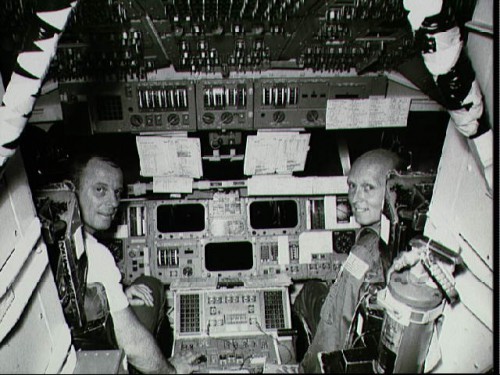
Following Haise’s retirement from NASA in June 1979, Jack Lousma (left) was promoted from the pilot’s seat to the commander’s seat. Teamed with fellow astronaut Gordon Fullerton (right), he went on to fly the third Space Shuttle mission in March 1982. Photo Credit: NASA
Ten days before Christmas 1978, Frosch glumly advised then-President Jimmy Carter that a Skylab reboost was out of the question and the station was inserted into a solar-inertial, high-drag attitude during January 1979. A few weeks later, NASA announced that it would cease round-the-clock monitoring of Skylab. By June, Fred Haise had resigned from NASA and Lousma—although promoted to the commander’s seat and given his own shuttle mission, which flew in March 1982—never got the chance to revisit Skylab. As for the old station, it spectacularly re-entered the atmosphere to destruction in July 1979.
It can never be known how Skylab might have been utilized had the shuttle rescue and the arrival of saviors Fred Haise and Jack Lousma taken place; it might have been refurbished and revisited throughout the 1980s, with U.S. astronauts returning to the realm of long-duration spaceflight more than a decade before the International Space Station (ISS). In many ways, therefore, the loss of Skylab was a loss of a unique opportunity for the U.S. human space program at a pivotal juncture in its history.
.
.
FOLLOW AmericaSpace on Facebook and Twitter!
.
.




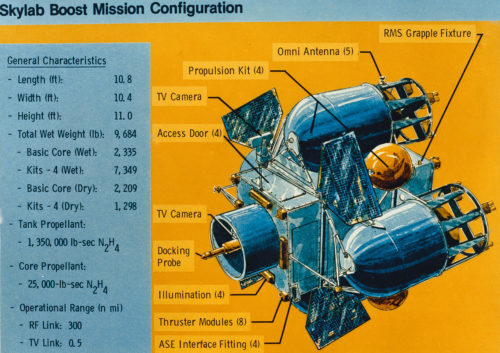
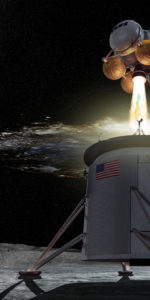
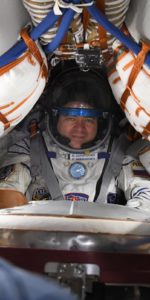
Upon consideration, it may not have been such a good idea as seemed on the surface.
https://web.archive.org/web/19990822213359/http://www.friends-partners.org/~mwade/articles/skyyfate.htm
Both Jim’s and Ben’s articles provide a very interesting and comprehensive perspective on the Skylab a d Shuttle programs. Jim’s concluding statement says it best. We must move forward.